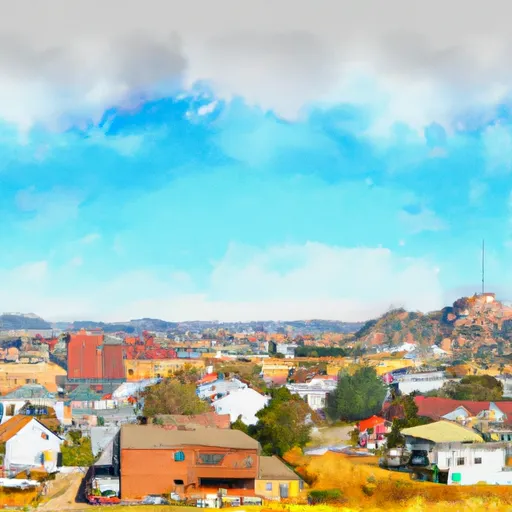-
 Snoflo Premium
Snoflo Premium
Get unlimited access to all our content
With no Ad interruptions! - Start Your Free Trial Login with existing account
Loma
Eden Index
Climate
8.9
•
Recreation
6.1
•
Community
0.8
•
Safeguard
5.9/10

Loma, Colorado is a small community located in Mesa County, nestled along the Colorado River in the western part of the state. The town experiences a semi-arid climate, characterized by hot summers and mild winters. Summers are typically dry with temperatures reaching the upper 90s (°F), while winters are mild with average temperatures in the 40s and occasional snowfall. Loma enjoys over 300 days of sunshine each year, making it an ideal destination for outdoor activities.
The hydrology of Loma is centered around the Colorado River, which provides ample opportunities for water-based recreation. The river serves as a popular spot for rafting, kayaking, and fishing for species such as trout and smallmouth bass. Additionally, the area is dotted with various lakes and reservoirs, including Highline Lake State Park, which offers boating, swimming, and camping facilities.
Beyond water activities, Loma and its surrounding areas offer a wide range of outdoor recreation opportunities. Hiking and mountain biking trails, like the Kokopelli Trail and the Tabeguache Trail, provide stunning views of the rugged desert landscapes. The nearby Colorado National Monument offers breathtaking vistas, rock climbing, and wildlife spotting opportunities. Loma truly caters to outdoor enthusiasts, providing an abundance of activities to enjoy in its beautiful natural surroundings.
What is the Eden Index?
The Snoflo Eden Index serves as a comprehensive rating system for regions, evaluating their desirability through a holistic assessment of climate health, outdoor recreation opportunities, and natural disaster risk, acknowledging the profound impact of these factors on livability and well-being.
Climate Health Indicator (CHI): 8.9
Loma receives approximately
243mm of rain per year,
with humidity levels near 56%
and air temperatures averaging around
11°C.
Loma has a plant hardyness factor of
6, meaning
plants and agriculture in this region thrive during a short period during spring and early summer. Most
plants will die off during the colder winter months.
By considering the ideal temperature range, reliable water supplies, clean air, and stable seasonal rain or snowpacks, the Climate Health Indicator (CHI) underscores the significance of a healthy climate as the foundation for quality living.
A healthy climate is paramount for ensuring a high quality of life and livability in a region, fostering both physical well-being and environmental harmony. This can be characterized by ideal temperatures, reliable access to water supplies, clean air, and consistent seasonal rain or snowpacks.
Weather Forecast
Streamflow Conditions
Colorado Headwaters
Area Rivers
Colorado Headwaters
Snowpack Depths
Colorado Headwaters
Reservoir Storage Capacity
Colorado Headwaters
Groundwater Levels
Recreational Opportunity Index (ROI): 6.1
The Recreational Opportunity Index (ROI) recognizes the value of outdoor recreational options, such as parks, hiking trails, camping sites, and fishing spots, while acknowledging that climate plays a pivotal role in ensuring the comfort and consistency of these experiences.
Access to outdoor recreational opportunities, encompassing activities such as parks, hiking, camping, and fishing, is crucial for overall well-being, and the climate plays a pivotal role in enabling and enhancing these experiences, ensuring that individuals can engage in nature-based activities comfortably and consistently.
Camping Areas
| Campground | Campsites | Reservations | Toilets | Showers | Elevation |
|---|---|---|---|---|---|
| Highline Lake State Park | 25 | 4,725 ft | |||
| Saddlehorn - Colorado National Monument | 80 | 4,685 ft | |||
| Miracle Rock | 4 | 6,572 ft | |||
| North Fruita Desert | 35 | 5,392 ft | |||
| Mud Springs | 14 | 8,525 ft | |||
| Fruita - Colorado River State Park | 45 | 4,484 ft | |||
| Divide Fork | 11 | 8,746 ft |
Catastrophe Safeguard Index (CSI):
The Catastrophe Safeguard Index (CSI) recognizes that natural disaster risk, encompassing floods, fires, hurricanes, and tornadoes, can drastically affect safety and the overall appeal of an area.
The level of natural disaster risk in a region significantly affects safety and the overall livability, with climate change amplifying these risks by potentially increasing the frequency and intensity of events like floods, fires, hurricanes, and tornadoes, thereby posing substantial challenges to community resilience and well-being.
Community Resilience Indicator (CRI): 0.8
The Community Resilience Indicator (CRI) recognizes that education, healthcare, and socioeconomics are crucial to the well-being of a region. The CRI acknowledges the profound impact of these elements on residents' overall quality of life. By evaluating educational resources, healthcare accessibility, and economic inclusivity, the index captures the essential aspects that contribute to a thriving community, fostering resident satisfaction, equity, and social cohesion.

